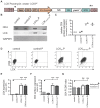The productive entry pathway of HIV-1 in macrophages is dependent on endocytosis through lipid rafts containing CD4
- PMID: 24465876
- PMCID: PMC3899108
- DOI: 10.1371/journal.pone.0086071
The productive entry pathway of HIV-1 in macrophages is dependent on endocytosis through lipid rafts containing CD4
Abstract
Macrophages constitute an important reservoir of HIV-1 infection, yet HIV-1 entry into these cells is poorly understood due to the difficulty in genetically manipulating primary macrophages. We developed an effective genetic approach to manipulate the sub-cellular distribution of CD4 in macrophages, and investigated how this affects the HIV-1 entry pathway. Pluripotent Stem Cells (PSC) were transduced with lentiviral vectors designed to manipulate CD4 location and were then differentiated into genetically modified macrophages. HIV-1 infection of these cells was assessed by performing assays that measure critical steps of the HIV-1 lifecycle (fusion, reverse transcription, and expression from HIV-1 integrants). Expression of LCK (which tethers CD4 to the surface of T cells, but is not normally expressed in macrophages) in PSC-macrophages effectively tethered CD4 at the cell surface, reducing its normal endocytic recycling route, and increasing surface CD4 expression 3-fold. This led to a significant increase in HIV-1 fusion and reverse transcription, but productive HIV-1 infection efficiency (as determined by reporter expression from DNA integrants) was unaffected. This implies that surface-tethering of CD4 sequesters HIV-1 into a pathway that is unproductive in macrophages. Secondly, to investigate the importance of lipid rafts (as detergent resistant membranes - DRM) in HIV-1 infection, we generated genetically modified PSC-macrophages that express CD4 mutants known to be excluded from DRM. These macrophages were significantly less able to support HIV-1 fusion, reverse-transcription and integration than engineered controls. Overall, these results support a model in which productive infection by HIV-1 in macrophages occurs via a CD4-raft-dependent endocytic uptake pathway.
Conflict of interest statement
Figures







Similar articles
-
Nef-induced CD4 endocytosis in human immunodeficiency virus type 1 host cells: role of p56lck kinase.J Virol. 2009 Jul;83(14):7117-28. doi: 10.1128/JVI.01648-08. Epub 2009 May 13. J Virol. 2009. PMID: 19439470 Free PMC article.
-
Human immunodeficiency virus type 1 uses lipid raft-colocalized CD4 and chemokine receptors for productive entry into CD4(+) T cells.J Virol. 2002 May;76(10):4709-22. doi: 10.1128/jvi.76.10.4709-4722.2002. J Virol. 2002. PMID: 11967288 Free PMC article.
-
Segregation of CD4 and CXCR4 into distinct lipid microdomains in T lymphocytes suggests a mechanism for membrane destabilization by human immunodeficiency virus.J Virol. 2002 Feb;76(4):1802-15. doi: 10.1128/jvi.76.4.1802-1815.2002. J Virol. 2002. PMID: 11799176 Free PMC article.
-
Human immunodeficiency virus and host cell lipids. Interesting pathways in research for a new HIV therapy.Prog Lipid Res. 2002 Jan;41(1):27-65. doi: 10.1016/s0163-7827(01)00019-4. Prog Lipid Res. 2002. PMID: 11694268 Review.
-
Cell surface down-modulation of CD4 after infection by HIV-1.FASEB J. 1994 Jun;8(9):593-600. doi: 10.1096/fasebj.8.9.8005387. FASEB J. 1994. PMID: 8005387 Review.
Cited by
-
CD4+ T Cell Subsets and Pathways to HIV Latency.AIDS Res Hum Retroviruses. 2018 Sep;34(9):780-789. doi: 10.1089/AID.2018.0105. Epub 2018 Jul 9. AIDS Res Hum Retroviruses. 2018. PMID: 29869531 Free PMC article. Review.
-
HIV cell-to-cell transmission: effects on pathogenesis and antiretroviral therapy.Trends Microbiol. 2015 May;23(5):289-95. doi: 10.1016/j.tim.2015.02.003. Epub 2015 Mar 9. Trends Microbiol. 2015. PMID: 25766144 Free PMC article. Review.
-
Emerging Role of LY6E in Virus-Host Interactions.Viruses. 2019 Nov 3;11(11):1020. doi: 10.3390/v11111020. Viruses. 2019. PMID: 31684192 Free PMC article. Review.
-
Concise Review: Modeling Neurodegenerative Diseases with Human Pluripotent Stem Cell-Derived Microglia.Stem Cells. 2019 Jun;37(6):724-730. doi: 10.1002/stem.2995. Epub 2019 Mar 10. Stem Cells. 2019. PMID: 30801863 Free PMC article. Review.
-
Human Induced Pluripotent Stem Cell-Derived Macrophages for Unraveling Human Macrophage Biology.Arterioscler Thromb Vasc Biol. 2017 Nov;37(11):2000-2006. doi: 10.1161/ATVBAHA.117.309195. Epub 2017 Oct 5. Arterioscler Thromb Vasc Biol. 2017. PMID: 28982665 Free PMC article. Review.
References
-
- Harbison MA, Gillis JM, Pinkston P, Byrn RA, Rose RM, et al. (1990) Effects of recombinant soluble CD4 (rCD4) on HIV-1 infection of monocyte/macrophages. The Journal of infectious diseases 161: 1–6. - PubMed
-
- Collin M, Herbein G, Montaner L, Gordon S (1993) PCR analysis of HIV1 infection of macrophages: virus entry is CD4-dependent. Research in virology 144: 13–19. - PubMed
Publication types
MeSH terms
Substances
Grants and funding
LinkOut - more resources
Full Text Sources
Other Literature Sources
Research Materials
Miscellaneous

